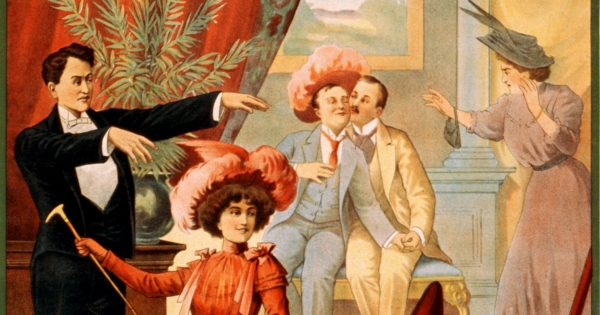Through the second half of the 19th century and the early part of the 20th century Christmas brought with it an expectation of charitable aid to the poor around the town, manifested through initiatives like the Christmas Coal Fund, which aimed to help those less fortunate in meeting the added burden of heating their homes during Winter. The unfortunate inmates of Midleton Workhouse (now Midleton Hospital) were another group who benefited from Yuletide initiatives, offering an all too brief respite from the desperate conditions in which they found themselves. During the late 19th century, one of the biggest Christmas events in the town was the annual event held for the Workhouse children, when presents and entertainments (such as music, magic lantern shows and even hypnotists) were laid on by the town’s more fortunate inhabitants.
One of the earliest references to Christmas in Midleton Workhouse appears in the Leinster Express of 25th December 1852. At the conclusion of the Famine, the paper noted that the poor in Waterford Workhouse were being given 1lb of beef each for dinner on Christmas Day, while at Midleton “the paupers have been treated to reduced rations.” Later Christmases did bring some respite, as noted by the Cork Examiner on 20th December 1875. By that date the tradition of giving gifts to the Workhouse children each year had been established. On 23rd December 1875 some of the most notable people of the locality– including Mrs. T.S. Coppinger, Mrs. Ashlin, Mrs. S. Coppinger, Miss. Fitzgerald, Miss Power, Rev. D. Lynch and the Rev. PJ Horgan– arrived to distirbute the gifts. They were handed out in the girls’ school room, which was decorated for the occasion with laurels and “appropriate mottoes” including a “Caed-mille-failthe” display made from ivy leaves intertwined with shamrocks. One of the boys in the Workhouse read out an address, which thanked Mrs. Coppinger and the Board of Guardians for their interest in the children’s welfare. Father Lynch responded to express his:
“satisfaction…at the good order and regularity which they saw exhibited by the children; exhorted them to be always kind and forebearing to each other; obedient and respectful to their superiors, and by doing so, to merit a renewal of the favours shown to them by Mrs. Coppinger and the other kind ladies who had come forward so generously to contribute to their happiness at this holy season.”

Children at Crumpsall Workhouse in England, c. 1895. The Midleton children likely presented a similar appearance (Manchester Archives)
In line with Victorian concepts of the deserving poor, Father Lynch also exhorted the children to:
“pay the greatest attention to their school studies and the other duties appertaining to their station in life, reminding them that they were in possession of advantages denied to a great many poor children in the world. By doing so they would make themselves respectable and useful members of society…”.
Following the speeches Mrs. Coppinger distributed the gifts, which included sweetmeats and toys, while the children also sang a number of songs. The newspaper noted that:
“The joy shown on the faces of the little ones as each new and wonderful toy was presented, created the greatest amusement to the visitors, who, when departing, declared themselves highly gratified with the day’s proceedings, which wound up with a three times three for the ladies.”

A Victorian-era Christmas Tree. The gifts for the Midleton Workhouse children were placed on the tree and a draw was held to see who received what. There were usually different gifts for girls and boys, and in addition sweets and exotic fruits were often also to be found on the tree (Harper’s Bazaar)
Christmas entertainments for the poor children remained a common theme at the Workhouse, and Mrs. T.S. Coppinger maintained a long association with it. More than a decade later, the 24th December 1887 edition of the Cork Examiner recorded that she had brought the children tea, sweets, sweetcakes, toys and books, and noted that she:
“has never forgotten to visit the Midleton Workhouse at this festive season of Christmas, and her efforts to afford the juvenile inmates of the Midleton Workhouse a happy Christmas will bring to herself many happy returns of the coming New Year.”
The tradition of giving to the children was still alive in the 1890s. On 11th January 1896 the Cork Examiner reported that the poor children of the Workhouse had been given their Christmas treat “through the generosity of the kind-hearted people of the town,” and a Christmas tree laden with “dainties and nick-nacks” was also provided for them. The children were allocated their gift from the tree via a draw (among the exotics that adorned it were fruits, such as oranges).
Christmas also saw the annual erection of a crib in the Workhouse Chapel. There was often additional charity for the older inmates of the Workhouse as well. In 1897 all the Workhouse residents were able to enjoy an evening of vocal and musical entertainment, together with a magic lantern show of continental scenes put on by P. Hallinan of Avoncore. The room in the Workhouse where the show was held was festively decorated, and during intervals songs and piano forte solos were given by local amateur musicians. A similar gift-giving exercise for the children in 1897 also included the distribution of tobacco and snuff to the aged and infirm inmates, though bad weather that year meant that the “kind ladies and gentlemen of the town, who annually patronise the workhouse entertainments were precluded from attending on this occasion” (Cork Examiner 9th January 1897, 11th January 1898).

In 1897 P. Hallinan of Avoncore put on a magic lantern show at the Workhouse. This was an extremely popular form of entertainment in the late 19th century. This image shows a magic lantern show in the United States in 1897, where an image of St. Peter’s Basilica is being shown to the audience (T.H. McAllister Company)
The Christmas Fete at Midleton Workhouse continued into the 20th century. One wonders what became of many of these children who, at least for one day, found themselves a focus of attention. To give readers a flavour of how the event was reported, below is a full transcript of the article on the proceedings from the Cork Examiner of 9th January 1901:
FETE AT MIDLETON WORKHOUSE
The annual fete and entertainment for the enjoyment of the children at the Midleton Workhouse came off in the schoolroom of that institution on Sunday last, in the presence of a large number of the townspeople. The general attendance also included- the Very Rev Canon Hutch, PP, DD, VF, Midleton; Rev CS O’Connor, CC, do, and the Nuns of the Workhouse. The room was tastefully decorated with evergreens and suitable mottoes, and in the centre was a large Christmas Tree heavily laden with a fine selection of toys and other gifts for the children, kindly provided through the generosity of the townspeople. When the proceedings began at two o’clock the whole surroundings presented a very pleasing aspect, and one could not fail being struck by the bright and happy faces of the little ones as they filed into their allotted seats under the care of their teachers, Mr and Mrs O’Sullivan, their school-teachers. A beautiful supply of cake, tea, and fruit was distributed amongst them by the good nuns, and whilst engaged in the agreeable occupation of doing justice for the good things provided, the entertainment of vocal and instrumental music was proceeded with. The first item was a song with chorus, “The Holy City,” by Mr W Ronayne, who was heard with much pleasure, and being loudly encored he sang with much feeling and expressions, “The Tempest of the Heart.” Mr D O’Sullivan, a Cork baritone of great promise, sang tastefully, “Savourneen Deelish,” his rich deep voice and fine intonation being highly appreciated. Mr John Bastible acquitted himself well in the rendering of “Queen of the Earth,” and was followed, by Mr William Cashman, whose fine tenor voice was heard in the singing of “When other Lips,” for which he was deservedly encored. The selections from “Les Cloches de Cornville” played on the violin by Miss Fitzgerald, with piano accompaniment by Mr C Byrne, was admirably performed, the uniqueness of touch and execution displayed by this youthful performer being much appreciated. The principal feature of the entertainment was the hypnotic exhibition given by Mr P C Leahy, Midleton, which was simply marvellous, the audience being amazed at the many strange feats in the hypnotic trance. This concluded the entertainment, after which the different prizes on the Christmas Tree were drawn for and distributed by the nuns. The Rev Canon Hutch then addressed a few felicitous remarks to the children, congratulating them on the success of the entertainment, and on their behalf he thanked the Nuns, the Master (Mr Daly) Mr and Mrs O’Sullivan, and also the various gentlemen who contributed to the entertainment. Three hearty cheers were then given by the youthful audiences for all the visitors who had so kindly attended, and did so much brighten and relieve the monotony of their Workhouse lives, and lusty cheers were also given for the esteemed Pastor, the Nuns, and the Master, Mr Daly, to whom much credit is due.

Hypnotism Shows were popular forms of entertainment at the turn of the 20th century. PC Leahy of Midleton put on such a show at Midleton Workhouse in 1901 (Extravagance of Hypnotism).
Further Reading
Workhouses.org: Midleton Workhouse



